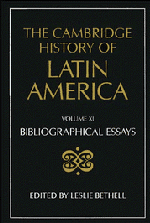Book contents
- Frontmatter
- I THE INDIGENOUS PEOPLES OF MIDDLE AND SOUTH AMERICA ON THE EVE OF THE CONQUEST
- II COLONIAL SPANISH AMERICA
- III COLONIAL BRAZIL
- IV THE INDEPENDENCE OF LATIN AMERICA
- V LATIN AMERICA: ECONOMY, SOCIETY, POLITICS, c. 1820 TO c. 1870
- 1 Post-independence Spanish America: Economy and society
- 2 Post-independence Spanish America: Society and politics
- 3 Mexico
- 4 Central America
- 5 Haiti and the Dominican Republic
- 6 Cuba, c. 1760–c.1860
- 7 Venezuela, Colombia and Ecuador
- 8 Peru and Bolivia
- 9 Chile
- 10 The River Plate republics
- 11 Brazil, 1822–1850
- 12 Brazil, 1850–1870
- VI LATIN AMERICA: ECONOMY, SOCIETY, POLITICS, c. 1870 to 1930
- VII LATIN AMERICA: ECONOMY, SOCIETY, POLITICS, 1930 to c. 1990
- VIII IDEAS IN LATIN AMERICA SINCE INDEPENDENCE
- IX LATIN AMERICAN CULTURE SINCE INDEPENDENCE
- X THE INTERNATIONAL RELATIONS OF LATIN AMERICA SINCE INDEPENDENCE
- THE CAMBRIDGE HISTORY OF LATIN AMERICA
1 - Post-independence Spanish America: Economy and society
from V - LATIN AMERICA: ECONOMY, SOCIETY, POLITICS, c. 1820 TO c. 1870
Published online by Cambridge University Press: 28 March 2008
- Frontmatter
- I THE INDIGENOUS PEOPLES OF MIDDLE AND SOUTH AMERICA ON THE EVE OF THE CONQUEST
- II COLONIAL SPANISH AMERICA
- III COLONIAL BRAZIL
- IV THE INDEPENDENCE OF LATIN AMERICA
- V LATIN AMERICA: ECONOMY, SOCIETY, POLITICS, c. 1820 TO c. 1870
- 1 Post-independence Spanish America: Economy and society
- 2 Post-independence Spanish America: Society and politics
- 3 Mexico
- 4 Central America
- 5 Haiti and the Dominican Republic
- 6 Cuba, c. 1760–c.1860
- 7 Venezuela, Colombia and Ecuador
- 8 Peru and Bolivia
- 9 Chile
- 10 The River Plate republics
- 11 Brazil, 1822–1850
- 12 Brazil, 1850–1870
- VI LATIN AMERICA: ECONOMY, SOCIETY, POLITICS, c. 1870 to 1930
- VII LATIN AMERICA: ECONOMY, SOCIETY, POLITICS, 1930 to c. 1990
- VIII IDEAS IN LATIN AMERICA SINCE INDEPENDENCE
- IX LATIN AMERICAN CULTURE SINCE INDEPENDENCE
- X THE INTERNATIONAL RELATIONS OF LATIN AMERICA SINCE INDEPENDENCE
- THE CAMBRIDGE HISTORY OF LATIN AMERICA
Summary
Roberto Cortés Conde and Stanley J. Stein (eds.), Latin America: A Guide to Economic History (1830–1930) (Berkeley, 1977) is a comprehensive survey of existing secondary literature which concentrates on Argentina, Brazil, Chile, Colombia, Peru and Mexico. Ciro F. S. Cardoso and Héctor Pérez Brignoli, Historia Económica de América Latina, 2 vols. (Barcelona, 1979) is a general economic history of Latin America which includes a valuable chapter (vol. 2, ch. 4) on the post-independence period. See also Tulio Halperín Donghi, Historia contemporánea de América Latina (Madrid, 1969; Eng. trans., Durham, N.C., 1993), chaps. 3 and 4 and The Aftermath of Revolution in Latin America (New York, 1973).
On the commercial and financial relations between the new Spanish American states and Britain in the period after independence, besides the classic The Migration of British Capital to 1875, by Leland H. Jenks (New York, 1927; reissued London, 1971) and J. Fred Rippy, British Investment in Latin America, 1822–1949 (Minneapolis, Minn., 1959), see D. C. M. Platt, Latin America and British Trade, 1806–1914 (London, 1973). Sergio Villalobos R., El comercio y la crisis colonial: Un mito de la independencia (Santiago, Chile, 1968), goes further than Platt in limiting the impact of the opening of trade after independence. The collection of articles edited by Reinhard Liehr, América Latina en la época de Simón Bolívar: Laformación de las economías nacionales y los intereses económicos europeos, 1800–1850 (Berlin, 1989), while taking into account the larger European background, puts most of its emphasis on the national and even local socio-economic transitions during the early nineteenth century.
- Type
- Chapter
- Information
- The Cambridge History of Latin America , pp. 247 - 252Publisher: Cambridge University PressPrint publication year: 1995



